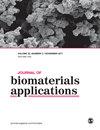Hierarchically porous surface of HA-sandblasted Ti implant screw using the plasma electrolytic oxidation: Physical characterization and biological responses
IF 2.3
4区 医学
Q3 ENGINEERING, BIOMEDICAL
引用次数: 0
Abstract
The surface topological features of bioimplants are among the key indicators for bone tissue replacement because they directly affect cell morphology, adhesion, proliferation, and differentiation. In this study, we investigated the physical, electrochemical, and biological responses of sandblasted titanium (SB-Ti) surfaces with pore geometries fabricated using a plasma electrolytic oxidation (PEO) process. The PEO treatment was conducted at an applied voltage of 280 V in a solution bath consisting of 0.15 mol L利用等离子电解氧化技术使喷砂钛植入螺钉的 HA 表面形成分层多孔:物理特性和生物反应
生物植入物的表面拓扑特征是骨组织替代的关键指标之一,因为它们会直接影响细胞形态、粘附、增殖和分化。在这项研究中,我们研究了采用等离子电解氧化(PEO)工艺制造的具有孔隙几何形状的喷砂钛(SB-Ti)表面的物理、电化学和生物反应。等离子电解氧化处理是在 0.15 mol L-1 一水醋酸钙和 0.02 mol L-1 甘油磷酸钙组成的溶液槽中,在 280 V 的外加电压下进行的,持续时间为 3 分钟。在含有一水醋酸钙和甘油磷酸钙的溶液槽中,经羟基磷灰石颗粒的 PEO 处理喷砂 Ti 植入体(PEO-SB-Ti)的表面化学性质、润湿性、机械性能和腐蚀行为随着磷钙多孔氧化物层的分布而得到改善,并呈现出具有纳米孔簇的均匀分层多孔表面。为了证明 PEO-SB-Ti 的功效,我们研究了这种植入物是否会影响生物反应。对拟议的 PEO-SB-Ti 进行了评估,目的是获得一种能有效诱导成骨分化和抗菌的多功能骨替代模型。这些物理和生物反应表明,与对照组相比,PEO-SB-Ti 在用作人工骨替代物方面具有很大的潜力。
本文章由计算机程序翻译,如有差异,请以英文原文为准。
求助全文
约1分钟内获得全文
求助全文
来源期刊

Journal of Biomaterials Applications
工程技术-材料科学:生物材料
CiteScore
5.10
自引率
3.40%
发文量
144
审稿时长
1.5 months
期刊介绍:
The Journal of Biomaterials Applications is a fully peer reviewed international journal that publishes original research and review articles that emphasize the development, manufacture and clinical applications of biomaterials.
Peer-reviewed articles by biomedical specialists from around the world cover:
New developments in biomaterials, R&D, properties and performance, evaluation and applications
Applications in biomedical materials and devices - from sutures and wound dressings to biosensors and cardiovascular devices
Current findings in biological compatibility/incompatibility of biomaterials
The Journal of Biomaterials Applications publishes original articles that emphasize the development, manufacture and clinical applications of biomaterials. Biomaterials continue to be one of the most rapidly growing areas of research in plastics today and certainly one of the biggest technical challenges, since biomaterial performance is dependent on polymer compatibility with the aggressive biological environment. The Journal cuts across disciplines and focuses on medical research and topics that present the broadest view of practical applications of biomaterials in actual clinical use.
The Journal of Biomaterial Applications is devoted to new and emerging biomaterials technologies, particularly focusing on the many applications which are under development at industrial biomedical and polymer research facilities, as well as the ongoing activities in academic, medical and applied clinical uses of devices.
 求助内容:
求助内容: 应助结果提醒方式:
应助结果提醒方式:


